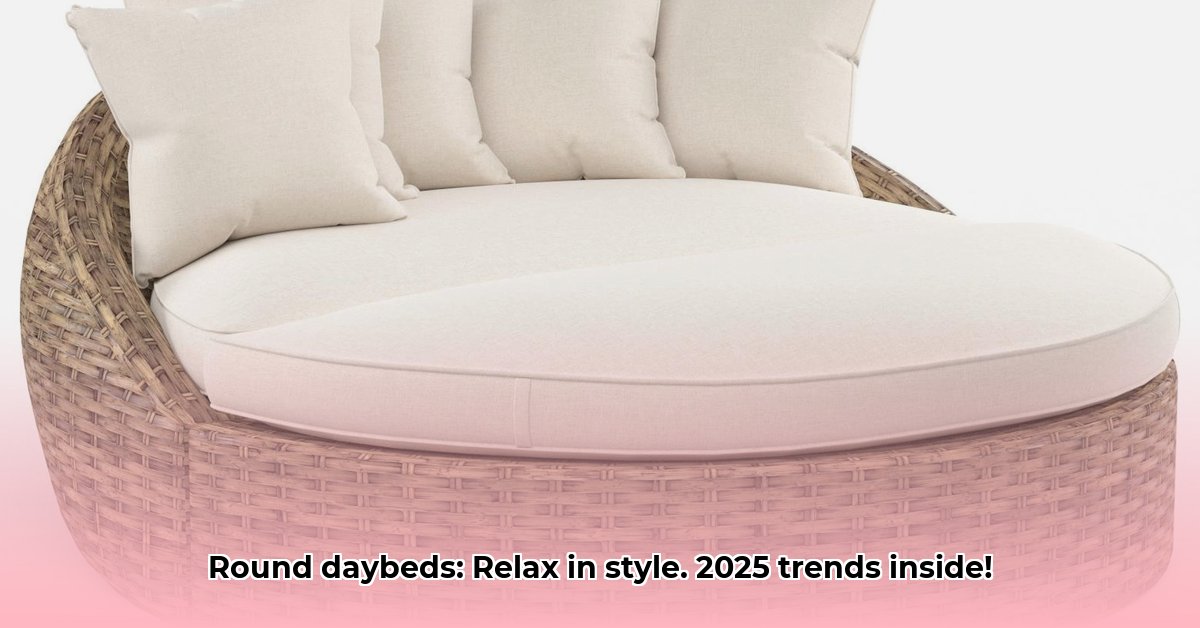Ready to turn your outdoor space into a relaxing retreat? Round outdoor daybeds are a popular choice for adding style and comfort to patios and decks. For a wide selection, check out these round daybeds. This guide provides essential information to help you choose the perfect daybed, covering materials, comfort features, styles, and upcoming trends to create your ultimate outdoor escape.
Decoding Daybed Design: Materials, Comfort, and Aesthetic Trends
Choosing the right round outdoor daybed can transform your patio or deck into a relaxing oasis. Let’s break down everything you need to know to make an informed decision.
Material Selection: Balancing Durability and Design
Selecting the right material impacts the longevity and aesthetic of your daybed. Key factors include durability, weather resistance, maintenance needs, and price. Let’s explore the most common options:
| Material | Advantages | Disadvantages | Maintenance |
|---|---|---|---|
| Wicker | Naturally beautiful, lightweight, often budget-friendly, flexible design options | Can be less durable, prone to moisture damage, may fade in direct sunlight | Regular cleaning with a soft brush and mild soap, occasional re-staining/sealing needed |
| Metal | Durable, weather-resistant, modern aesthetic, strong and supportive | Can get scorching hot in direct sun, potential for rust if not properly treated, can be heavy to move | Occasional cleaning, rust prevention may be necessary, consider a protective coating |
| Wood | Classic charm, sturdy and strong, provides a natural and warm feel | Needs more upkeep, susceptible to rot and decay if not properly sealed, can be expensive depending on type | Regular cleaning, sealing, occasional refinishing, protection from extreme weather |
| Aluminum | Lightweight, rustproof, low-maintenance, recyclable | Can dent easily, sometimes less visually appealing, may require cushions for added comfort | Simple cleaning, occasional spot treatment needed |
Choosing the right material is essential for long-term satisfaction. Consider your local climate and lifestyle when making your selection. For instance, coastal regions might benefit from rust-resistant aluminum, while drier climates might be suitable for well-maintained wood.
Prioritizing Comfort: Cushions and Seating Dynamics
Comfort is a top priority when selecting a daybed. Cushion quality significantly impacts your relaxation experience. Consider the plushness, support, and weather resistance of the cushions. Also, think about the number of people you usually expect to relax on it. Will you need extra pillows for added lumbar support? Look for cushions made with solution-dyed acrylic fabrics, known for their resistance to fading, mold, and mildew.
Investing in high-quality cushions is crucial for a truly relaxing experience; this could mean the difference between a dreamy nap and an uncomfortable experience. Consider foam density and filling materials for optimal support. High-density foam is more durable and provides better support than lower-density options.
Style and Design: Aligning with Your Outdoor Décor
Your round outdoor daybed should complement your existing outdoor style, whether it’s modern, traditional, bohemian, or unique. A sleek metal frame can enhance a contemporary garden, while a wicker daybed can add charm to a vibrant patio. Consider the size and shape of your space. Smaller daybeds suit balconies, while larger ones can be centerpieces on spacious decks. Think about incorporating outdoor rugs, throw pillows, and ambient lighting to create a cohesive and inviting outdoor atmosphere.
Smart Buying: Your Daybed Checklist
Before purchasing a daybed, consider these essential factors:
- Budget Allocation: Determine how much you’re willing to spend. Account for potential delivery fees and assembly costs.
- Spatial Measurement: Ensure the daybed fits comfortably by carefully measuring your patio or deck. Consider the space needed for movement around the daybed.
- Stylistic Harmony: Select a style that complements your existing decor. Consider the color palette and overall aesthetic of your outdoor space.
- Material Assessment: Consider the climate and maintenance requirements when choosing materials. Research the specific properties of each material to make an informed decision.
- Comfort Evaluation: Prioritize cushion quality, padding, and pillow inclusion. Test the daybed in person if possible to assess its comfort level.
- Durability Inspection: Choose a strong, weather-resistant design. Look for reinforced frames and high-quality construction.
- Warranty and Return Policy: Check the warranty and return policy before making a purchase. This will protect you in case of any defects or issues.
Maintenance Strategies: Protecting Your Investment
Regular maintenance is key to extending your daybed’s lifespan, ensuring it remains a comfortable space for years. Regular cleaning, using protective covers, and occasional spot treatments are all useful methods. Invest in furniture covers specifically designed for outdoor daybeds to protect them from the elements.
Forecasting Trends: Daybeds in 2025 and Beyond
Experts predict future trends in outdoor furniture will favor sustainable materials and modular designs, aligning with sustainable living and flexible spaces. Expect more eco-friendly options and daybeds that can adapt to changing needs. More research will be useful to understanding how these trends will evolve. Look for daybeds made from recycled plastics, reclaimed wood, and other sustainable materials. Modular designs will allow you to customize your daybed to fit your specific needs and space. Integrated technology, such as built-in lighting and charging ports, could also become more prevalent.
How to Choose Sustainable Round Outdoor Daybeds
Round outdoor daybeds are increasingly popular, offering versatile style and comfort. Choosing sustainable options involves prioritizing eco-friendly materials and ethical manufacturing. Look for certifications like Fair Trade to ensure ethical labor practices.
Material Choices: Durability & Eco-Friendliness
Selecting the right materials is crucial when choosing sustainable round outdoor daybeds. Consider these options:
- Sustainable Wood: Naturally durable woods like teak, cedar, and acacia are excellent choices. Look for Forest Stewardship Council (FSC) certified wood. However, maintenance is key. Use natural oils and waxes for sealing and protecting the wood.
- Recycled Aluminum: Lightweight and recyclable, aluminum offers durability. Look for powder-coated finishes for weather protection. Powder coating is a more environmentally friendly alternative to traditional painting methods.
- Sustainable Wicker: Synthetic wicker offers lower maintenance and enhanced durability. Opt for recycled or sustainably sourced materials. Look for wicker made from recycled plastic bottles or other post-consumer waste.
- Eco-Friendly Fabrics: Choose fabrics made from recycled materials or organic cotton. Consider recycled polyester or natural latex fills. Look for fabrics that are free from harmful chemicals and dyes.
| Material | Pros | Cons | Sustainability Considerations |
|---|---|---|---|
| Sustainable Wood | Durable, naturally beautiful, can be sustainably sourced, adds warmth and character to outdoor spaces | Requires regular maintenance, can be expensive, susceptible to damage from pests and moisture if not properly treated | Look for FSC certification; choose slower-growing species to ensure responsible harvesting; consider using reclaimed wood; use non-toxic sealants and finishes. |
| Recycled Aluminum | Lightweight, strong, recyclable, rust-resistant, requires minimal maintenance | Can be more expensive than other materials, can get hot in direct sunlight, may require cushions for added comfort | Ensure it’s made from recycled content; choose powder-coated finishes instead of traditional painting methods; look for manufacturers with responsible recycling programs. |
| Sustainable Wicker | Durable, stylish, can be made from recycled materials, weather-resistant, low-maintenance | May require more maintenance than natural wicker, can look less natural | Seek recycled or sustainably harvested materials; look for wicker made from recycled plastic bottles; choose manufacturers with transparent supply chains. |
| Eco-Friendly Fabrics | Comfortable, sustainable materials available, wide range of colors and patterns, can be made from recycled materials | May require more frequent cleaning, can be more expensive than conventional fabrics | Look for certifications like GOTS or OEKO-TEX; choose fabrics made from organic cotton, recycled polyester, or other sustainable materials; avoid fabrics treated with harmful chemicals. |
Optimizing Comfort and Design
Comfort is paramount. Key aspects to consider include:
- Cushion Quality: High-density foam or recycled fillings provide comfort. Look for removable covers for easy cleaning. Choose cushions with UV protection to prevent fading.
- Seating Arrangement: Consider your needs; do you want a single lounging spot, or enough space to comfortably accommodate several people? Opt for modular designs that can be reconfigured to suit your needs.
- Style Compatibility: Does the style complement your outdoor space? Consider the overall aesthetic of your outdoor space and choose a daybed that blends seamlessly with your existing furniture and décor.
Purchasing Steps for Sustainability
- Budget Definition: Set a realistic budget to guide your search. Factor in the cost of sustainable materials and ethical manufacturing.
- Needs Assessment: Determine seating capacity and maintenance preferences. Consider how you plan to use the daybed and choose features that meet your specific needs.
- Material Research: Explore sustainable options like wood, aluminum, and fabrics. Research the environmental impact of each material before making a decision.
- Feature Comparison: Consider cushion quality and additional features. Look for features like adjustable canopies and built-in storage.
5.
- Modern Kitchen Backsplash Ideas To Inspire Your Refresh - December 19, 2025
- Modern Backsplash Ideas: A Guide to Todays Kitchen Trends - December 18, 2025
- Ceramic Kitchen Wall Tiles: Style and Protection for Your Walls - December 17, 2025









